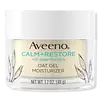What's inside
What's inside
 Key Ingredients
Key Ingredients

 Benefits
Benefits

 Concerns
Concerns

 Ingredients Side-by-side
Ingredients Side-by-side

Water
Skin ConditioningGlycerin
HumectantDimethicone
EmollientCetearyl Olivate
Avena Sativa Kernel Flour
AbrasiveSorbitan Olivate
EmulsifyingPolyacrylamide
Synthetic Beeswax
Emulsion StabilisingPhenoxyethanol
PreservativeC13-14 Isoparaffin
EmollientButylene Glycol
HumectantDimethicone Crosspolymer
Emulsion StabilisingPanthenol
Skin ConditioningChlorphenesin
AntimicrobialDimethiconol
EmollientCarbomer
Emulsion StabilisingLaureth-7
EmulsifyingChrysanthemum Parthenium Flower/Leaf/Stem Juice
AntioxidantEthylhexylglycerin
Skin ConditioningSodium Hydroxide
BufferingAvena Sativa Kernel Extract
AbrasiveCentella Asiatica Extract
CleansingWater, Glycerin, Dimethicone, Cetearyl Olivate, Avena Sativa Kernel Flour, Sorbitan Olivate, Polyacrylamide, Synthetic Beeswax, Phenoxyethanol, C13-14 Isoparaffin, Butylene Glycol, Dimethicone Crosspolymer, Panthenol, Chlorphenesin, Dimethiconol, Carbomer, Laureth-7, Chrysanthemum Parthenium Flower/Leaf/Stem Juice, Ethylhexylglycerin, Sodium Hydroxide, Avena Sativa Kernel Extract, Centella Asiatica Extract
Water
Skin ConditioningPropanediol
SolventCalophyllum Inophyllum Seed Oil 10%
AntimicrobialDipropylene Glycol
HumectantNiacinamide
SmoothingCarthamus Tinctorius Seed Oil
MaskingCetearyl Olivate
Polysorbate 60
EmulsifyingRosa Canina Fruit Oil
EmollientGlyceryl Oleate
EmollientSorbitan Olivate
EmulsifyingSorbitan Oleate
EmulsifyingOctyldodecanol
EmollientGlycerin
HumectantButylene Glycol
HumectantSodium Hyaluronate
HumectantSqualane
EmollientSerine
MaskingAcetyl Glutamine
Skin ConditioningGlycine
BufferingCeramide NP
Skin ConditioningOleic Acid
EmollientSodium PCA
HumectantGlycosyl Trehalose
Emulsion StabilisingCaprylic/Capric Triglyceride
MaskingGlycine Soja Sterols
EmollientSaccharide Isomerate
HumectantAvena Sativa Kernel Flour
AbrasiveDisodium Phosphate
BufferingSodium Phosphate
BufferingTocopheryl Acetate
AntioxidantCoco-Caprylate/Caprate
EmollientLactic Acid
BufferingXanthan Gum
EmulsifyingUrea
BufferingHydroxyethyl Acrylate/Sodium Acryloyldimethyl Taurate Copolymer
Emulsion StabilisingHydrogenated Olive Oil Unsaponifiables
EmollientMagnesium Chloride
1,2-Hexanediol
Skin ConditioningHydroxyacetophenone
AntioxidantGlyceryl Caprylate
EmollientPentylene Glycol
Skin ConditioningCaprylyl Glycol
EmollientDisodium EDTA
Water, Propanediol, Calophyllum Inophyllum Seed Oil 10%, Dipropylene Glycol, Niacinamide, Carthamus Tinctorius Seed Oil, Cetearyl Olivate, Polysorbate 60, Rosa Canina Fruit Oil, Glyceryl Oleate, Sorbitan Olivate, Sorbitan Oleate, Octyldodecanol, Glycerin, Butylene Glycol, Sodium Hyaluronate, Squalane, Serine, Acetyl Glutamine, Glycine, Ceramide NP, Oleic Acid, Sodium PCA, Glycosyl Trehalose, Caprylic/Capric Triglyceride, Glycine Soja Sterols, Saccharide Isomerate, Avena Sativa Kernel Flour, Disodium Phosphate, Sodium Phosphate, Tocopheryl Acetate, Coco-Caprylate/Caprate, Lactic Acid, Xanthan Gum, Urea, Hydroxyethyl Acrylate/Sodium Acryloyldimethyl Taurate Copolymer, Hydrogenated Olive Oil Unsaponifiables, Magnesium Chloride, 1,2-Hexanediol, Hydroxyacetophenone, Glyceryl Caprylate, Pentylene Glycol, Caprylyl Glycol, Disodium EDTA
 Reviews
Reviews

Ingredients Explained
These ingredients are found in both products.
Ingredients higher up in an ingredient list are typically present in a larger amount.
Oatmeal flour is created by grinding down the kernels of oats. Oatmeal helps sooth, hydrate, and protect the skin.
Oatmeal kernel flour has abrasive, or exfoliating, properties.
Learn all about the skin benefits of colloidal oatmeal here.
Learn more about Avena Sativa Kernel FlourButylene Glycol (or BG) is used within cosmetic products for a few different reasons:
Overall, Butylene Glycol is a safe and well-rounded ingredient that works well with other ingredients.
Though this ingredient works well with most skin types, some people with sensitive skin may experience a reaction such as allergic rashes, closed comedones, or itchiness.
Learn more about Butylene GlycolCetearyl Olivate is an emulsifier and texture enhancer. It is derived from the fatty acids of olive oil and Cetearyl alcohol, and is biodegradable.
As an emulsifier, it is used to prevent oils and waters from separating. It can also
Manufacturers use the name Olivem 1000. This ingredient has been found to preserve the natural microbiome of skin. Having a healthy microbiome helps keep our skin healthy and protects against harmful bacteria. This ingredient is grouped with Sorbitan Olivate under the name Olivem 1000.
Learn more about Cetearyl OlivateGlycerin is already naturally found in your skin. It helps moisturize and protect your skin.
A study from 2016 found glycerin to be more effective as a humectant than AHAs and hyaluronic acid.
As a humectant, it helps the skin stay hydrated by pulling moisture to your skin. The low molecular weight of glycerin allows it to pull moisture into the deeper layers of your skin.
Hydrated skin improves your skin barrier; Your skin barrier helps protect against irritants and bacteria.
Glycerin has also been found to have antimicrobial and antiviral properties. Due to these properties, glycerin is often used in wound and burn treatments.
In cosmetics, glycerin is usually derived from plants such as soybean or palm. However, it can also be sourced from animals, such as tallow or animal fat.
This ingredient is organic, colorless, odorless, and non-toxic.
Glycerin is the name for this ingredient in American English. British English uses Glycerol/Glycerine.
Learn more about GlycerinSorbitan Olivate is created from the fatty acids in olive oil and sorbitol.
This ingredient is an oil in water emulsifier. It helps stabilize a product by preventing oils and waters from separating. Sorbitan Olivate also helps hydrate the skin.
Manufacturers sell sorbitan olivate under the name OliveM 1000. OliveM 1000 a multifunctional ingredient. It is self-emulsifying. According to a manufacturer, OliveM 1000 does not disrupt natural skin biome.
Due to its olive oil base, this ingredient may not be fungal-acne safe.
Learn more about Sorbitan OlivateWater. It's the most common cosmetic ingredient of all. You'll usually see it at the top of ingredient lists, meaning that it makes up the largest part of the product.
So why is it so popular? Water most often acts as a solvent - this means that it helps dissolve other ingredients into the formulation.
You'll also recognize water as that liquid we all need to stay alive. If you see this, drink a glass of water. Stay hydrated!
Learn more about Water